Archive for ‘Office Supplies’ Category
Organize Your Thoughts & Your Desk with Desktop Whiteboards
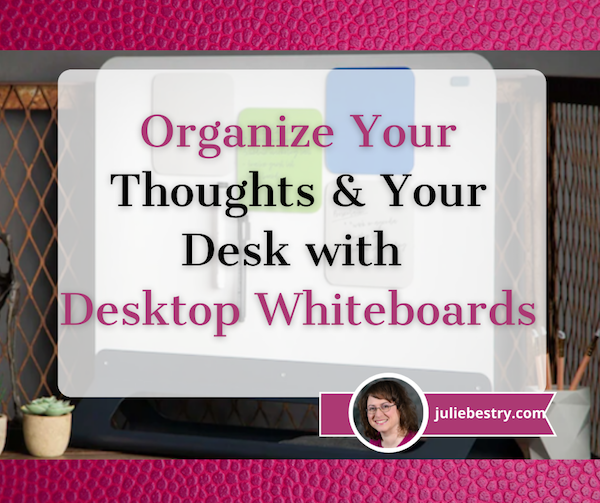
Over the last two years, we’ve understandably seen a vast increase in people working from home. As they’ve done so, they’ve transitioned from those early ad hoc set-ups at the dining room table using chairs better suited for celebrating Thanksgiving than spending eight hours in front of a computer. Little by little, we’ve all added the items that made office work, if not outright enjoyable, at least little more efficient and comfortable.
However, a number of my clients who’ve fully embraced working from home have commented that they miss whiteboards. For some, it’s the collaborative nature; for others, it’s the ease of grabbing a chunky pen and writing on something fixed-in-place.
The impermanence of the words — let’s face it, a whiteboard is just a dry-erase board with a 21st century title — doesn’t seem to bother most people because of the sense of the fixed-in-place aspect of the whiteboards themselves. A loose piece of paper may get buried; a sticky note might flutter into the trash. But a note on a whiteboard stays until you wish it to depart.
However, even if you’ve made your dining room, spare bedroom, or other space in the house into an office, complete with desk and chair, lighting and filing space, you may not have invested in a whiteboard like you had in your olden-days office. But have you considered a desktop whiteboard?
BENEFITS OF DESKTOP WHITEBOARDS
While a desktop whiteboard isn’t always a perfect solution, it can have appealing advantages. A desktop whiteboard is (or can be):
Installation-free — Maybe you’re handy, but Paper Doll is not. My walls are embarrassingly bare, as even though I can find a stud (no jokes, please), the sheetrock in my apartment is pretty “meh.” I’d rather not hang or install anything too heavy. Plus, if your office is in a highly visible area of your home, you may not want a massive whiteboard clashing with your decor. Instead of installing a whiteboard on the wall, opting for a smaller profile item might be appealing.
Portable — Do you need to be mobile? Depending on your work style, you may move around your home or sometimes set yourself up in coffee houses or co-working spaces. If you’re a student, you may split your time between your home or dorm desk and your carrel at the university library.
And even if you do go into the office, more and more companies are going hybrid and eliminating assigned desks, opting for hot-desking where you work at a different desk each time you come in. With all of these situations, wouldn’t having a portable whiteboard you can use on your desk be a nice option?
Analog — To be sure, I’m a big fan of digital note-taking. Have I mentioned that I just completed re-certification as an Evernote Certified Expert?
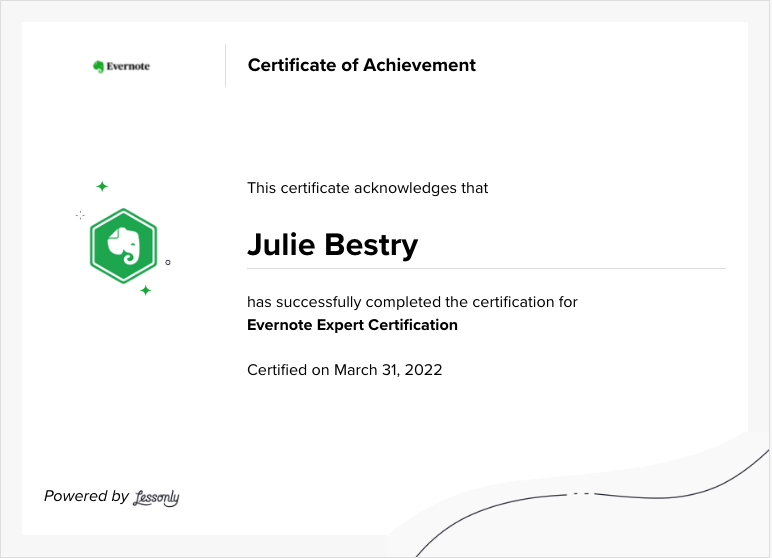
However, for a lot of us, tiny bits of information need to stay in front of us for almost-immediate use. There are many times where we just want to quickly capture a phone number, name, turn of phrase, or concept, and the fastest way to do this is by grabbing a pen and writing it down.
I’m a pacer — when I’m on the telephone and really in sync with the person with whom I’m conversing, I can get most of my 10,000 Fitbit steps a day logged while chatting and pacing the room. While I could definitely go back to my desk, sit down, open a task app or Evernote screen, it’s going to be more convenient for me to scribble on a small whiteboard.
Sure, I could write on a sticky note, but on a busy day, that might lead to a snowstorm of stickies across my desk, which isn’t particularly eco-friendly.
And yes, I could take advantage of the newest Evernote feature, Evernote Helper to make a quick note. If you’ve got Evernote running in the background, just click Control + Command + H on a Mac or Control + Alt + H on a Windows PC, then type (or copy & paste) information into the resulting mini-note; clicking anywhere else on the screen takes you back to what you were doing and the note hides until you want or need it. I could explain further, but my buddy Dr. Frank Buck created a whole video post on this very topic.)
My point, and I do have one, is that there are times when an analog approach to capturing small pieces of information works best, and a whiteboard can be the way to do it.
Motivational — Again, yes, a digital approach can be motivational. On my iPhone, a reminder to be mindful pops up on my screen (with an associated ding) every time I get out of the car. It asks me, “What are you tolerating?” to help me align with the concepts I discussed in Organize Away Frustration: Practice The Only Good Kind of “Intolerance.”
On my Mac, when I hit F3 to get to my little dictionary app, I also get a screen of inspirational digital sticky notes I’ve created, like these:
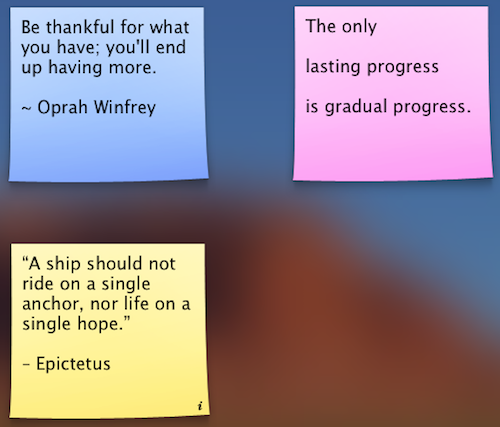
But back in ye olden days when I worked in television, I had a whiteboard on one wall and a bulletin board on another. As with most people, I let my bulletin board get cluttered, but my whiteboard served as an ideal spot to write the message of the day, whether it was one word, like RESILIENCE, or an entire message, like, “I have radical trust in the perfect unfolding of my life,” as we talked about in The Perfect Unfolding As We Work From Home.
Environmentally-appealing — Last week was Earth Day, so sustainable products have been on my mind. We should note that not all whiteboards are equally Earth-friendly. Most whiteboards are made of one of three types of materials: glass, porcelain, or melamine. Glass, obviously, is recyclable. Porcelain whiteboards (often made of ceramics with steel or aluminum backing to make them magnetic) are not easily recycled; melamine is not recyclable at all.
If sustainability is important to you, consider these factors when you pick any whiteboard option. (And check out the nifty steel options discussed later in this post!)
PREVIOUSLY ON PAPER DOLL
Last year, in Paper Doll Models the Spring 2021 Organizing Products, while looking at the the Quartet Portable Glass Dry-Erase Pad, I found something nifty on a grander scale. At the time, I wrote the following.
Quartet Desktop Glass Whiteboard Computer Pads
Quartet‘s Desktop Glass Whiteboard Computer Pads are just as environmentally friendly as their portable cousins, but they are designed to be used at the computer, where there’s far less chance of dropping them! (What?! I can’t be the only person who fears being klutzy and having a purse full of shattered glass!)
This two-pound, 18″ wide by 6″ high, angled organizing tool does double-duty. The contemporary-style glass top is made of a sleek, durable, dry-erase surface, designed to fit in with any office or home décor.
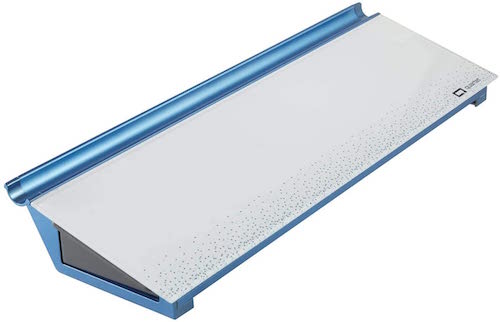
The non-porous glass does not absorb ink, so Quartet guarantees (for 15 years!) that it will not stain or ghost, and it’s made to resist dents and scratches in case you have a cat or tiny human (or co-worker who behaves like either one) visiting your desk. So, write your task list or the phone numbers you’re transcribing from voicemail, erase, write something completely new – all to your heart’s content.
The writing area is only part of what makes the Desktop Glass Whiteboard Computer Pad useful. The item as a whole is designed to sit between your keyboard and your monitor, and the built-in storage drawer slides out to expose space for markers, sticky notes, flash drives, and whatever you want to keep at your desk while maintaining a clutter-free work environment.
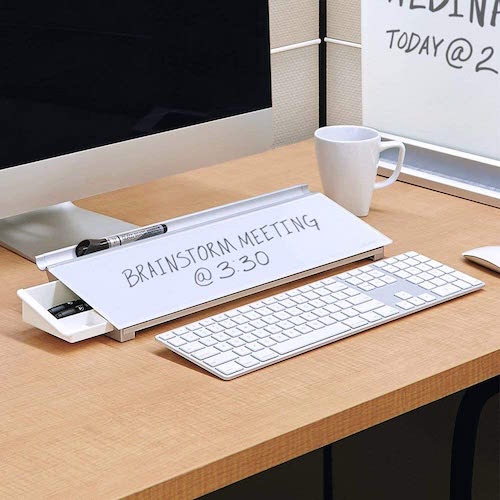
There’s also a small trough at the top of the angled surface where your dry-erase markers can nest comfortably until you write your next reminder.
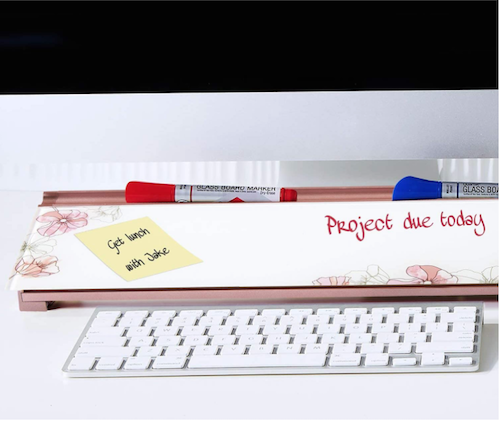
The Quartet Glass Dry-Erase Desktop Computer Pads come in five styles: White, Marble (grey with gold accents), Floral (white with pink accents), Dot (white with blue accents), and Black (with silver accents).
Reviewers advised that while a variety of dry-erase markers will work, the Quartet branded ones seem to have the best staying power and erase the most cleanly, so caveat emptor. I should also note that it’s not immediately obvious what color dry-erase ink colors would be visible on a black background. It appears the black version comes with white dry-erase marker.
The different versions range in price from $31-$40 on the Quartet website, and $29-$44 on Amazon.
Since the time I published that post, there’s been an explosion in the popularity and availability of desktop whiteboards. There hasn’t been this much excitement in the world of whiteboards since Tim Russert’s “Florida, Florida, Florida” in 2000!
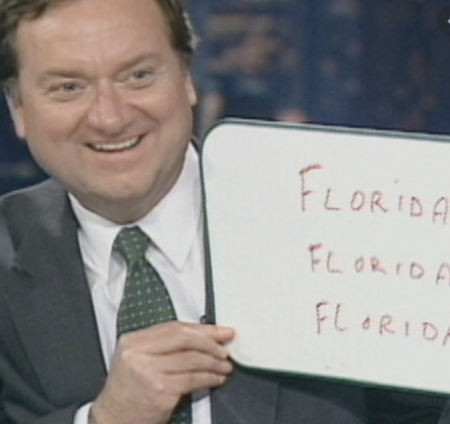
A BUFFET OF OPTIONS FROM FLUIDSTANCE
You might recognize Fluidstance from their ubiquitous balance board ads on Facebook, but I’ve become fascinated by their ever-increasing desktop products.
Fluidstance Slope Personal Desktop Whiteboard
First up is their Slope Personal Desktop Whiteboard, which takes an upscale twist on the usual whiteboard product. It’s not glass, porcelain, or melamine: it’s 100% heavy-duty steel (so it’s magnetic), and powder-coated using a low-emissions process.
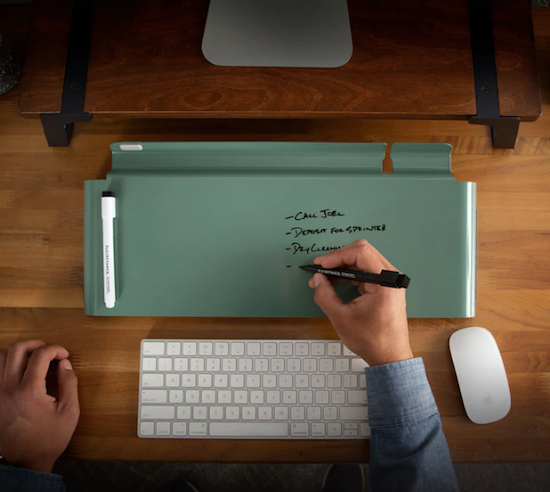
Manufactured in California, Fluidstance says Slope’s design is inspired by “an open, groomed ski run.” The angle is gentle for ease of writing and the top dry-erase surface is described as “premium.” Unlike the Quartet version, it doesn’t have a cubby for supplies, but it does have a channel at the top to nestle dry-erase markers and any other writing implements.
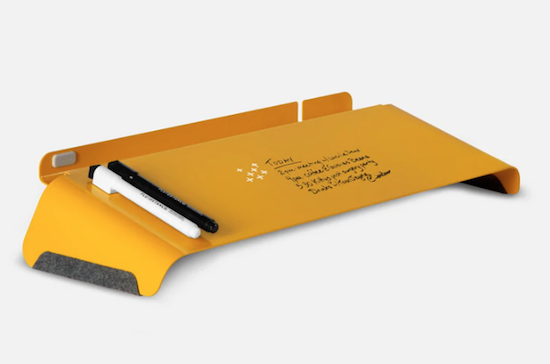
Slope’s raised surface lets you slide your keyboard underneath for storage, so you can free up space on you desk for when you’re having lunch (but seriously, don’t have lunch at your desk — get some fresh air!) or doing some other analog writing.
There are felt bumpers to protect your desk from scratches or other marks, and it (and all of the Fluidstance products mentioned below) comes with a microfiber eraser pouch in which the dry-erase pen is packed.
And, as of last month, Slope comes with a free silicone phone holder crafted to fit within the pen channel and keep your desk tidy.

Slope measures 20″ long (18 3/4″ underneath) by 8″ wide by 3 1/2″ high (at the highest point, and 1 1/4″ as the lower, near, end); it weighs about three pounds. Slope comes in five color schemes: White, Blue Steel, Slate (grey), Honeycomb (yellow) and, in a limited edition Sequoia (green); Slope costs $69 at the Fluidstance online store (and at Amazon, where only the white version is available).
Slope (as all their products) comes with a lifetime warranty; they will repair or replace items for free.
Fluidstance also has a Slope+ for $99 with all of the features of the Slope, plus a phone charger.
Fluidstance Edge
Do you write a lot? I mean, not necessarily as much as Paper Doll, but perhaps twice as much as you’d need to write to cover a Slope? I guess some of the folks at Fluidstance have the same issue, as they’ve developed the Edge, which is similar to the Slope, but with a reversible, double-sided writing surface in the same 100% heavy-duty steel.
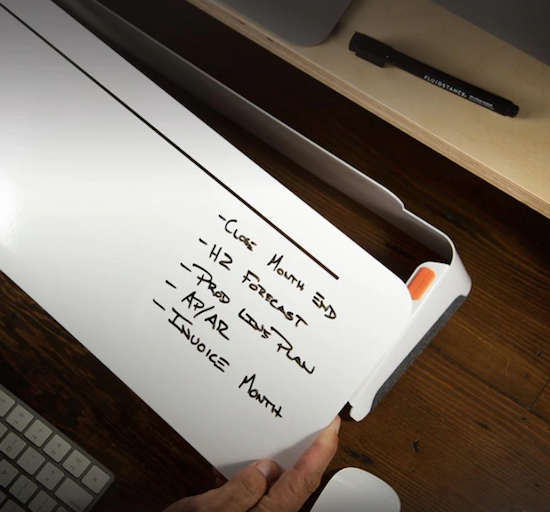
Of course, because it’s double-sided, there’s no marker channel (because, duh, the markers would fall out), and no phone holder. However, the metal base extends up through the writing surface to make a small “fence” where you can rest your markers temporarily.
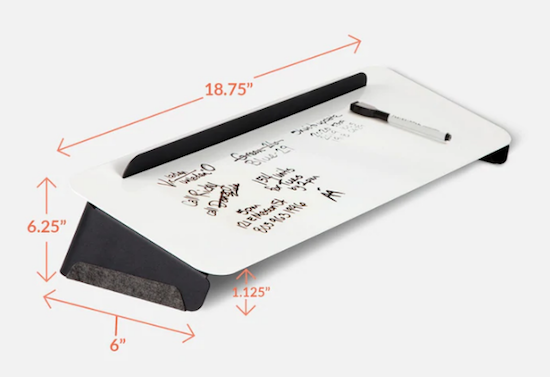
The Edge comes in white or black-and-white (with a white writing surface and a black metal base); it’s also $69. The measurements are slightly different from the Slope, as shown above.
Fluidstance Lift
The above options are ideal if you’re using a desktop (as I am) or a laptop with an external keyboard. Your little whiteboard fits right in that space between your fingers flying over the keyboard and your computer. But what if you’re using a laptop at a standing desk? What if you should be looking at a monitor that’s up a little higher? Fluidstance has you covered!
The Fluidstance Lift™ is a two-in-one personal whiteboard and laptop riser. It’s designed to improve your ergonomic set-up by “raising your laptop to the ideal height for viewing a primary or secondary monitor” while still giving you a great dry-erase space on a durable, 100% steel, powder-coated platform. Take a look at the video:
There are silicone grommets on the base to hold Lift in place while keeping the desk protected, and there’s a felt pad (made out of 100%-recycled plastic bottles) to nestle your laptop.
The Lift is $79 at the Fluidstance store.
Fluidstance Wall and Flow Cards
If the 100%-steel, magnetic whiteboard appeals to you but you want more elbow room, without having your whiteboard so close to the keyboard or computer, there are yet more options in store. The Fluidstance Wall is a freestanding, double-sided whiteboard wall suitable for sitting on your desk. Consider it a privacy screen combined with a whiteboard, eminently portable for when you’re working in a school library or coffee house or just in a distracting office space.
(For more on privacy screens, whether for safety or productivity, check out last year’s Paper Doll post, Divide and Conquer: Improve Productivity With Privacy Screens.)
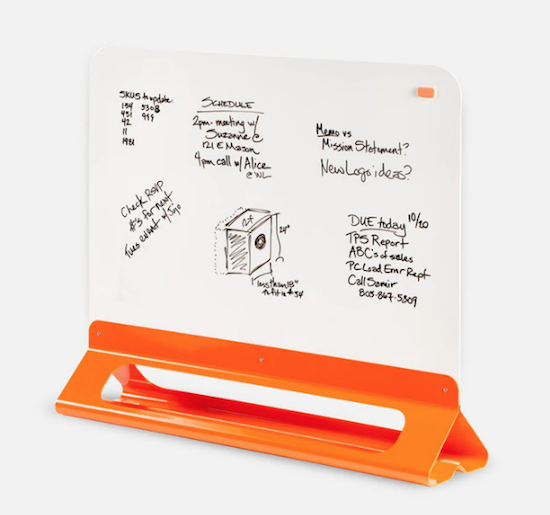
Use Wall on its own as a whiteboard or with Flow Cards (see below), or as a pin-up board with magnets. (Use your own, or get Fluidstance’s pushpin-like versions for $9.)
The base and wall are 24″ wide; the entire set-up measures 20″ high, though the vertical writing surface is just 15″. The base measures 5.6″ front-to-back.
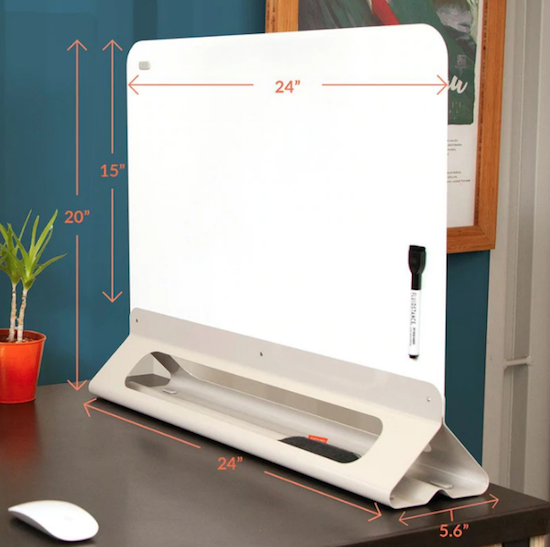
The Wall’s base comes in Blue Matte, Orange, or Grey, and has a 19″ x 2.5″ slot (accessible from all sides) for storing markers, pens, and other desk accessories.
The Wall is $99.
At the risk of sounding like a commercial from the 1980s, but wait, there’s more!
If you want a smaller profile for writing your notes when you’re on the go, or want to combine multiple surfaces with the Wall, you can go either way. Fluidstance’s Flow Cards are four round-edged square, magnetic, dry-erase cards. (You get two grey, one green, and one blue one to a set.)
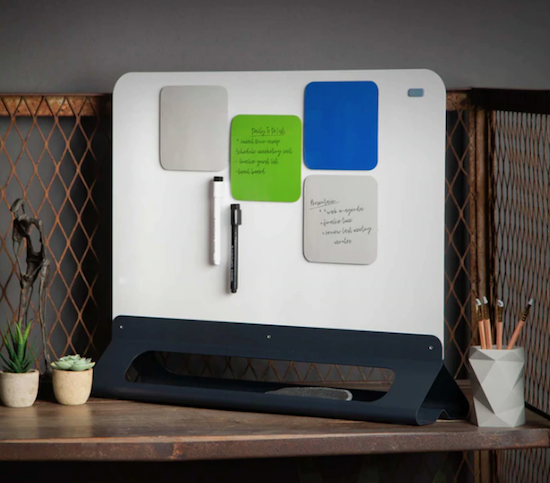
Purchase just the Flow Cards if you want to use them with the Wall, Edge, or Slope, or get a set combined with their 100% steel, white card holder (below).
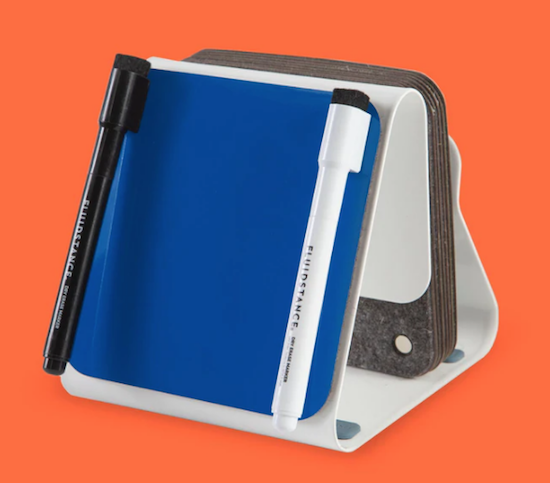
The front of the holder is also a magnetic whiteboard surface, and you can store up to eight Flow Cards in the rear of the holder. So organized!
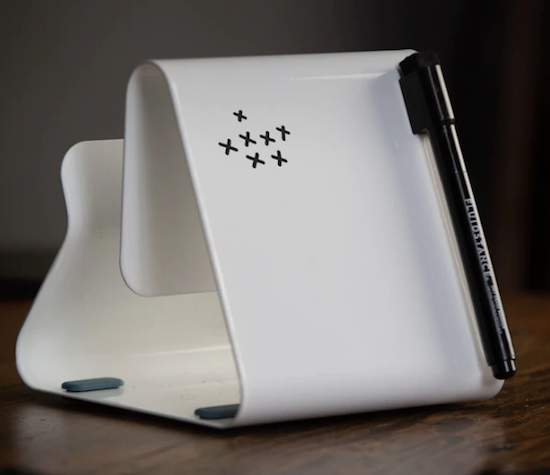
A set of Flow Cards is $35; a set sold with the holder is $59.
SIMILAR OPTIONS FROM DIFFERENT SOURCES
Did you like Fluidstance’s mixture of a privacy screen and a whiteboard, but you prefer to use your Amazon Prime account for everything?
VIVO Desktop Whiteboard is a freestanding 23″ x 19″ double-sided dry-erase board that also serves as a privacy divider.
On the Road Again: Organize Your Mobile Office
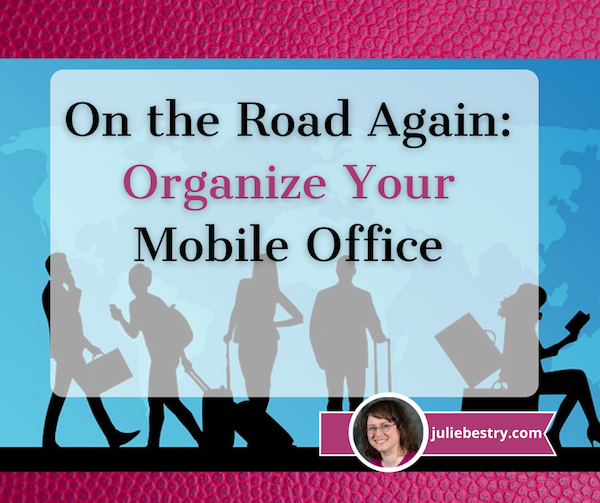
Road Warrior Image by Mohamed Hassan from Pixabay
During the last two years, the watchword has been “work from home.” In this recent WFH era, we’ve eschewed office buildings and turned snuggly corners of our bedrooms and dining rooms into home offices. Many companies have closed their local operations altogether, finally trusting that there’s no need to micromanage their knowledge-worker staffs. More and more, companies are OK with letting people work where and how they operate best.
Of course, this isn’t the case with everyone. Some employers are rushing at breakneck speed to return the North American workplace experience to “normal,” despite the distinct rise in European and Asian COVID cases of the Omicron BA.2 subvariant. Count me as one of those who is curmudgeonly aghast at the state-by-state dropping of precautions, as I noted in the following reply to a friend, which got a lot of Twitter love.
I am so tired of people saying it’s over because they want it to be over. It’s not a relationship, it’s a virus.
— Julie Bestry, CPO® (@ProfOrganizer) March 23, 2022
Obviously, though, there are some people who can’t work from home. Your favorite restaurant can’t let the sous-chef work from his back deck. An OB-GYN is the perfect example of how you can’t phone in every kind of delivery!
And people who travel about for work, whose very career depends on them physically arriving at different locations, whether locally, regionally, nationally, or internationally, need to get on the road (or the tarmac), however ambivalent they might feel about the prospect. And, of course, they need to be organized.
HOW TO ORGANIZE YOUR MOBILE OFFICE
From smart phones to Zoom to cloud computing, modern technology has made road warriors a little less embattled, but keeping your mobile office from looking like an outtake from Game of Thrones battle requires some special equipment and finesse.
Over twenty years as a professional organizer, I have worked with a wide variety of clients who work, at least some of the time, from the road.
There have been numerous pharmaceutical sales representatives who needed to organize medical literature, promotional materials, medication samples, durable medical goods, and anatomical models and schlep them from medical offices and hospitals in their assigned local or regional areas. I’ve worked with a few mobile pharmacists serving as pharmacy supervisors, traveling each week to different outlets, and working both as members of their profession and in consultant/supervisory capacities on behalf of their companies.
I had one client who traveled her “territories” in various parts of the country for a restaurant chain, training franchisees and their staff on everything from computer systems to how to prepare and garnish certain delicious foodstuffs. And one client shared memorable tales of his experiences as a high-level insurance executive assigned to travel and review high profile claims.
What all of these hearty folks had in common is that they needed to have all of their necessary office supplies, documents, and resources available to them with the same ease of accessibility as when they were comfortably seated in actual offices. While each had unique needs, their were a wide number of commonalities.
In the Car
Let’s focus on documents. Back at a decidedly stationary office, you’d have filing cabinets, hanging file drawers in a desk, and a variety of other options with the distinct advantage that you never need worry about jostling.
Cars, however, jostle. They are buffeted by the wind on the highway and hit unanticipated bumps from potholes and running over detritus that has fallen off of other vehicles.
If your mobile office requires bringing lots of glossy literature, forms, or other pre-printed material, you’ll want to approximate a standard filing system as much as possible.
Personally, I’m a fan of sturdy file crates. These crates, fashioned after old-school milk crates but with file rails on all four sides (to accommodate letter-sized or legal-sized files) take a licking and keep on ticking when you’ve got a heavy load of hanging files filled with file folders and lots of paper.
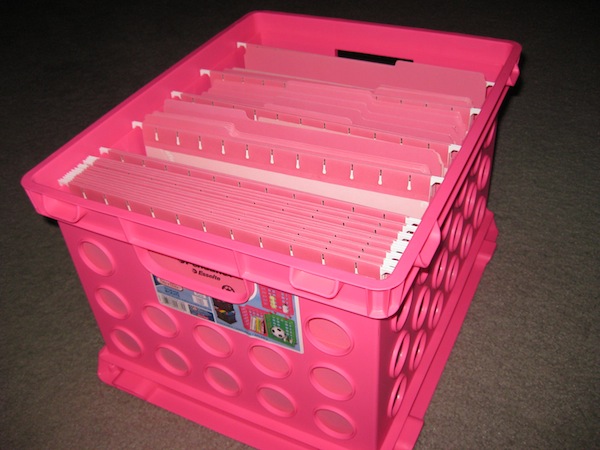
My favorite version is made by Sterilite and, like the very best versions of the TARDIS’s control room, has lots of “round things.” I own them in four different shades of pink/plum/mauve, plus blues and blacks. Another client swears by teal.
In most “big box” stores like Target or Walmart or office supply stores, you can usually fine single crates for $5-10. (Storex makes a very similar version, with weirder displays of “round things,” but usually only in packs of three or more for somewhat higher prices.)
In Search of Lost Time: Productivity, Proust, and the Culture of Availability
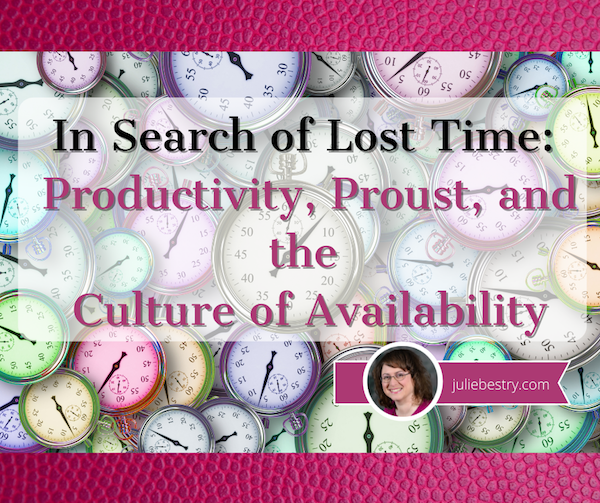
Marcel Proust’s seven-volume novel, In Search of Lost Time, translated from the French À La Recherche du Temps Perdu, was first translated into English as Remembrance of Things Past and is known for its theme of involuntary memory.
Ask Paper Doll: Should I Organize My Space and Time with Color?
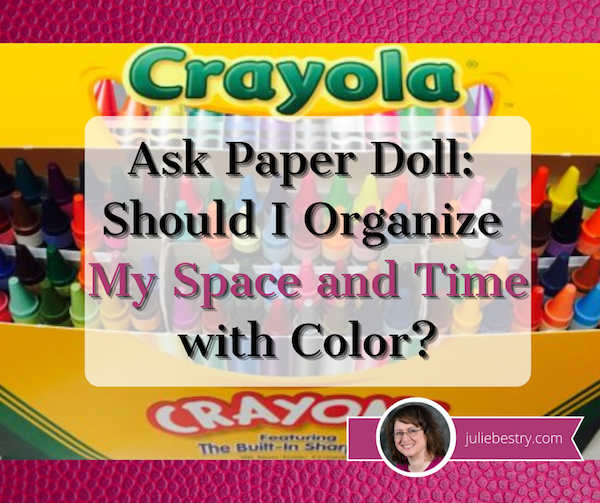
This is part of a recurring series of Ask Paper Doll posts where you can get your burning organizing questions answered by Paper Doll, a 20-year veteran professional organizer and amateur goofball.
Dear Paper Doll:
It’s only January and I’m already at a loss for motivation. I’ve been thinking about using color to organize my office and maybe my calendar, but the more I look at my options, the more overwhelmed I get. How can I organize by color and not constantly be tinkering with my systems and remembering what color goes where?
Signed,
Feeling grey with a case of the blues
Grey sky, grey streets, grey mood? Even if we weren’t in the second winter of a pandemic, January is a tough month to feel sparkly. We’re still nine weeks away from Daylight Saving Time, so our late afternoons are dark and gloomy. Plus, after the ongoing glow of holidays from late November through New Year’s Day, of course you’re feeling a loss of spark.
And yes, color is a great way to pump up the mood. If color weren’t so vital, Pantone wouldn’t be known worldwide for coming up with its color of the year. By the way, Paper Doll is a huge fan of this year’s color, Very Peri.
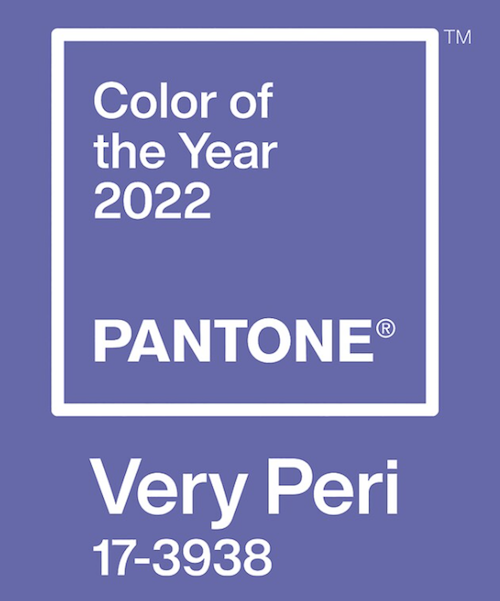
But organizing by color and organizing with color can be very different things.
ORGANIZING BY COLOR
Some people are enthusiastic about using color to organize everything in their homes, offices, and lives. Maybe they have a signature color that serves as a personal brand; others believe in color-coding and sorting everything by hue. Paper Doll isn’t necessarily keen on that. Using color to decide where something goes and with which it is grouped depends on the situation.
Organizing clothing or shoes by color? Sure. Imagine you have all of your long-sleeved shirts hanging in the closet, in roughly ROY-G-BIV color order, or group all your black pumps together, then the blue, then the red, and so-on within your collection of heels.
This will make it easy to recognize you’ve tipped the scale toward full-on goth when you’ve got 17 black turtlenecks, or may be mistaken for Dorothy if most of your shoes are ruby red. Sorting and ordering your clothes and shoes by color makes sense, but probably as a secondary sorting characteristic within clothing/shoe types.

Organizing your calendar by color? Absolutely! Whether you grab a selection of pretty markers to fill in your paper planner (medical appointments in red, billing or tax dates in green, social events in purple) or use the settings in Outlook, Gmail, or any other digital calendar, you can color-code to your heart’s delight.
And the best thing? If you select the wrong color, you don’t need white-out or an eraser to fix it. One little click, and you’re back in business!
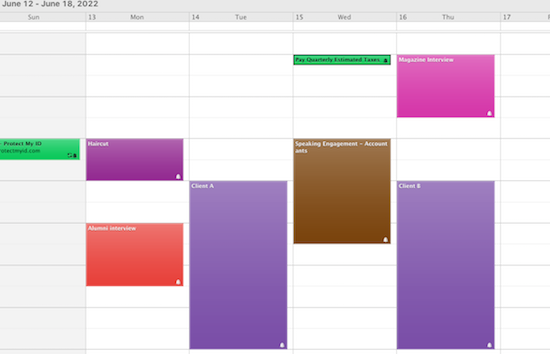
Organizing files by color? Mayyyyyyyybe. I hate to sound coy, but the effectiveness of a system based on color-coding files depends on the level of commitment of the user.
In the abstract, it can be great to organize your files (either tabbed folders or hanging folders) by color. Figure out what your overarching categories are, and assign colors to those categories, whether in your reference or action files. For example:
- Red folders — Urgent tasks or information you always need to get your hands on in a hurry
- Green folders — Financial information related to taxes, payable accounts, and investments
- Blue folders — Planning, like for vacations or work projects
- Yellow folders — Client information or class materials
- Purple folders — Creative tasks
and so on. Color (as we’ll see below) stirs emotions, creates enthusiasm and motivation, and triggers action. What could be better?
The problem isn’t with the system, per se, but with the users. If you let yourself run out of yellow folders just as you sign on a new client, what will you do? Are you likely to order new folders in that color scheme right away? If so, you’re set. If not, you may let a pile of papers related to that client languish in the corner of your desk, risking them getting mislaid or lost.
Plus, keeping many different boxes of colored tabbed folders can be expensive and get out of balance quickly. You may use three times as many purple folders as red ones and your red box may sit year after year, mostly untouched.
If you want to embrace color, there are a few other options beyond a full-on color-coding assault. You could:
- Pick your favorite color, and use those tabbed folders exclusively.
- Start with just two or three of your most used categories and pick colors to define each of those. You’ll still be using color as a sort of trigger or label, as above, but you won’t be going “whole hog,” at least not at the beginning.
- Use plain manilla tabbed folders, but pick a beloved color for hanging folders. (Because hanging folders hold tabbed folders, and can generally accommodate three-in-one, we don’t run out of them as quickly.) Traditional olive/army green hanging folders aren’t likely to cheer anyone up, and using a fun hanging folder uniformly through your filing system will brighten your mood without requiring you to keep up with a complex system.

(These purple Smead hanging folders are bright and bold, and are available in most Big Box stores and at Amazon for $17.89 for a box of 25.)
Organizing your spices by color? How experienced a chef are you that you could catch yourself before you added a visibly similar (but wrong) spice to a recipe? Ground nutmeg, cloves, and cinnamon look alike; but would you want to risk grabbing the wrong one and making iced nutmeg rolls or clove-raisin coffee cake?
Are you willing to mistake similarly-red cayenne pepper for paprika? Perhaps it’s better to group spices by the categories of usage (baking tasks vs. preparing meat/vegetables, etc.). SpiceAdvice has a nice Quick Reference Spice Chart sorted by usage categories.
Organizing your books by color? Oh, gracious. This question has stirred quite a bit of controversy over the last few years. I mean, there’s this person:
I feel like coordinating books by color is one of those things you either love or are wrong about. pic.twitter.com/U6GfIZLgnQ
— Jennifer Wright (@JenAshleyWright) July 15, 2020
I’d take umbrage, but I’m too busy worried about how cold her legs must be.
And then there’s Clea Shearer and Joanna Teplin from the Netflix program Get Organized with the Home Edit. They’re known for their passion for color-coding, and they did that with a few bookshelves on their show. But they were children’s books, and let’s face it, the way tiny humans pull books off shelves, it’s not like alphabetized books are going to stay that way. (Their background, at the above link, shows a full set of bookshelves for grownups arranged by color. I’m looking around for my fainting couch.)
Magazines have been rife with headlines in favor of organizing books by color. For example, Jezebel ran with a piece called Sorry, Color-Coded Bookshelves Look Good, while Slate stood up for the design-oriented folks with Arranging Your Books By Color Is Not a Moral Failure.
Of course, in this highly competitive media market, every online magazine’s job is to stir controversy and curry clicks. Thus, I suspect these headlines recognize that those of us who read may care more about the content of our books than using them as decor and are trying to drive some righteous indignation clicks to their sites.
But Paper Doll stands firmly in the NOPE category on organizing books by hue. The color of a book’s cover is about marketing; it was almost certainly chosen by a marketing team based on the designs in fashion for that genre during that season. The color may not even have been approved by the author or seem to make sense. I mean, even early versions of Alice Walker’s The Color Purple didn’t have a purple book cover or spine!
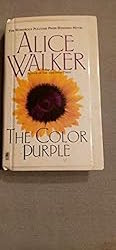 I’m a practical person. I believe that function should always come before form. A gorgeous outfit that doesn’t cover all your fleshy bits and gives you frostbite? Nuh-uh. A bookshelf that requires you to remember the color of the cover vs. letting you just walk over to peruse the category (fiction? organizing? recipes?) or authors? I can’t countenance that.
I’m a practical person. I believe that function should always come before form. A gorgeous outfit that doesn’t cover all your fleshy bits and gives you frostbite? Nuh-uh. A bookshelf that requires you to remember the color of the cover vs. letting you just walk over to peruse the category (fiction? organizing? recipes?) or authors? I can’t countenance that.
I’m not saying you can’t do it; I’m saying I can’t advise it.
And that’s because, as a professional organizer, my role is to help you live a more organized and productive life. Sure, I’ll leave your space looking better than it did before, but my reason for being in your space is to leave it working better than it did before.
ORGANIZING WITH COLOR
So, what’s the difference?
Organizing by color requires creating a system. With clothes or shoes, it might just be ROY-G-BIV and keeping things in order. When you put away your clothes, as you approach with a freshly-laundered shirts on hangers, you’ll be able to put away each item in the general color order. It’s your closet, so you don’t have to be too persnickety unless Vogue is coming to do a photo layout of your walk-in, in which case, good for you!
With file folders, as described above, organizing by color requires a stricter system. In effect, you’re deciding, up front, what all of your categories will be and assigning colors to those categories. You have to be willing to stop, each time you create a folder, to consider what category the contents of the folder belong to, and select that color every time. If you’re comfortable with that, then you have my blessing. I just don’t want to see you get stressed out.
You also have to be relatively sure that you’ll “feel” this association going forward (unless you’re just having fun and don’t care whether there’s a cognitive connection between your colors and your categories); if you soon realize that you hate the color orange but have assigned orange to your accounts payable, you might stop filing your paid bills or (eek!) avoid paying them altogether.
Organizing by color can be great, and I’m absolutely in favorite of it, as long as you, as an individual, feel comfortable sticking to a system. If not, that’s OK. There are still magnificent ways to organize your life with color, without adhering to strict or narrow categories.
Organizing with color lets you pick functional objects that add a pop of color but don’t require a lot of mental or physical effort to maintain.
It’s more thematic than systematic.
It’s sort of how we talked about about goals and resolutions vs. picking a word of the year. (If you haven’t read Review & Renew for 2022: Resolutions, Goals, and Words of the Year, this is a great time to help you get back on that motivation kick!) Goals — and the habits we embrace to achieve them — are like the systems for organizing by color; a word, mantra, or theme of the year, rather, provides a sense of focus, and color can do that for you.
Pantone does it with the color of the year; you can brand yourself, or your year, with color that’s meaningful to you! Think, “2022 in Royal Blue!” (Good luck rhyming a year with periwinkle or burnt sienna, though.)
Let’s get a sense of what color psychology tells us. Our friends at Quill created a nifty infographic to help explain some of the meanings of color.
Do you have to use the specific colors that are associated with specific feelings? Of course not. I don’t particularly find the color yellow to be “associated with hope, happiness, and positivity.” I don’t even buy the original yellow Post-it® Notes because yellow just doesn’t do it for me. (I’m so into pinks and purples, as you might have guessed.)
But do experiment and take advantage of the aspects of the psychology of color to make your space your own.
A FEW FUN WAYS TO INTRODUCE COLOR INTO YOUR LIFE THIS SEASON
Our friends at Time Timer have come up with some gorgeous, new colorful timers.
First, they’ve released their original 8″ timers in Learning Center Classroom Sets (of 3) in two different color schemes. But you don’t need to be using them in a classroom to brighten up your office or workspace. There’s a primary color set:
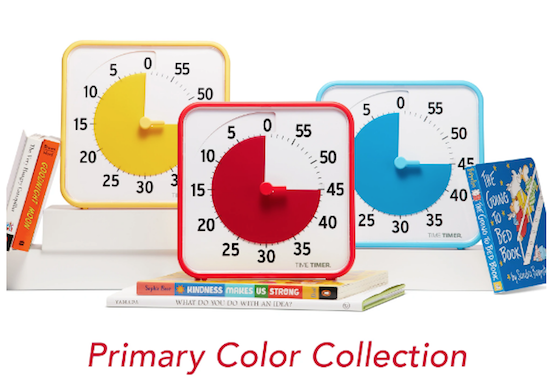
and a secondary color set:
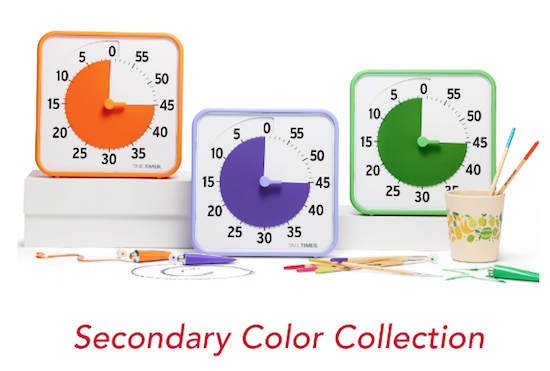
These sets are priced (for pre-order) at $104/set. Again, these are designed for learning activities, but there’s no reason why you couldn’t have one timer in your office, one in your kitchen, and one in your workout area.
Each set comes with three Original 8″ visual timers (for up to a 60-minute duration) with magnetic backs and fold-up feet, three dry erase cards for labeling the current activity (great for helping you focus during a 25-minute pomodoro task), and one free download of the Time Timer Desktop App.
They’re also selling a Time Timer MOD® – Special Edition Tie-Dye version (for pre-order) for $36.95. I’m a big fan of the little MODs, and this 3 1/2″ square MOD provides a tiny pop of color while helping you visualize time passing, and keep you motivated to accomplish your tasks.
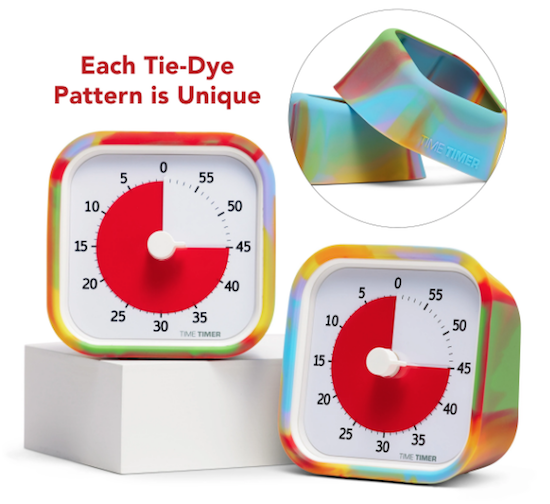
For a burst of color for office supplies, consider Poppin desk, wall, and office accessories:
You can buy their products directly from the Poppin website, or at Staples, Quill, and The Container Store. Be sure to check out Poppin’s Work From Home section for more fun, motivating bursts of color.
Do you like to wrap yourself up in color or just use it for accents?
Are you comfortable with intricate color-coding systems, or do you just want to surround yourself with your favorite hues?
And what’s your favorite color?
Meet me in the comments and tell all!
The Humble Index Card: Organize Your Life, Then Organize Your Cards
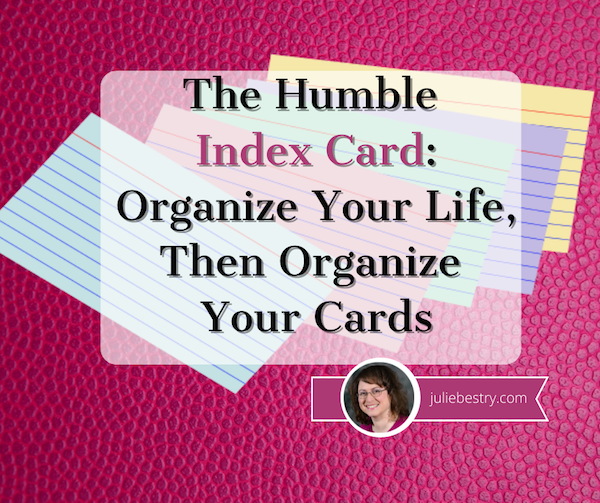
When was the last time you used an index card? Chances are, you don’t give a lot of respect to the humble three-by-five, but we owe so many of our systems, including almost every type of categorization and computerization, to what first got plotted out in a precursor of the little cards we know so well.
Index cards, of a sort, have been around ever since the 1760s, when Swedish botanist Carl Linnaeus, the father of modern taxonomy (the science of classification), figured out that he could name, categorize, and keep track of animals, plants, and minerals. All that Latin nomenclature, with genus and species and sub-species, needed to be written down somewhere, and Linnaeus figured out how to square it all away.
I know, it’s hard to believe someone had to invent an index card, but realize that file folders weren’t even invented until the late 1800s, filing cabinets came to market in 1898, and paper clips showed up around 1900. If you crave more about the history of office supplies — and I mean, who doesn’t? — you might like to check out:
A Place for Everything: The Curious History of Alphabetical Order by Judith Flanders (which is about so much more than just alphabetical order, and provides some eye-opening backward glances into how hard it was to organize information throughout most of recorded history).

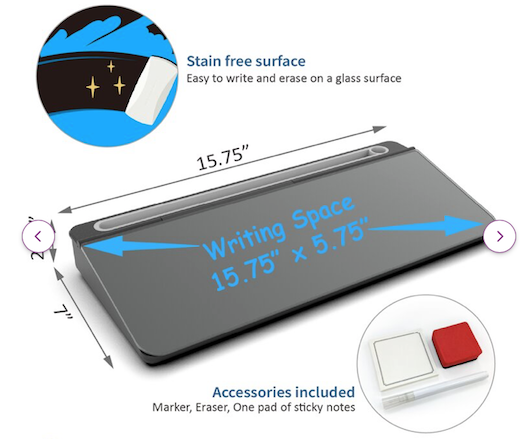
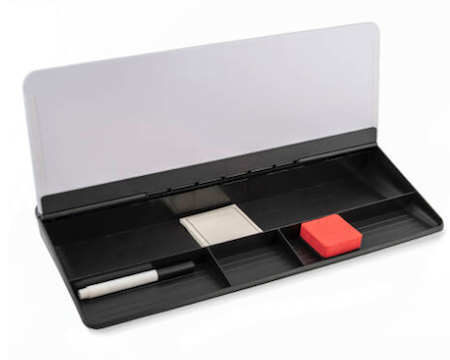
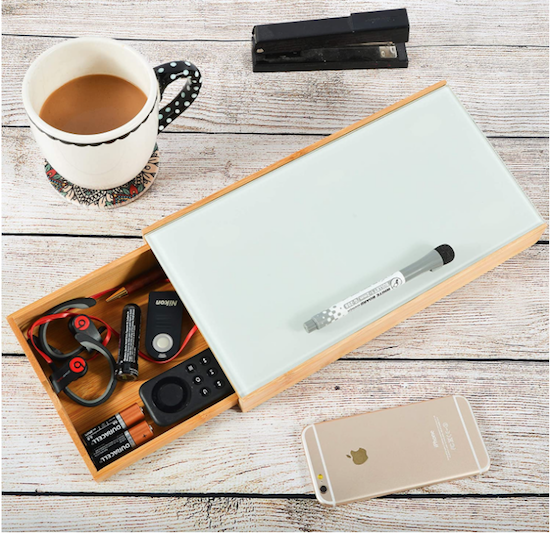



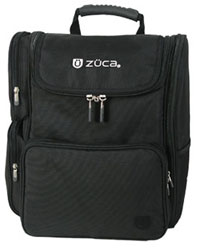
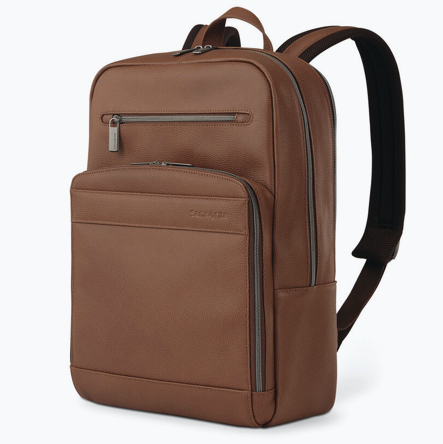
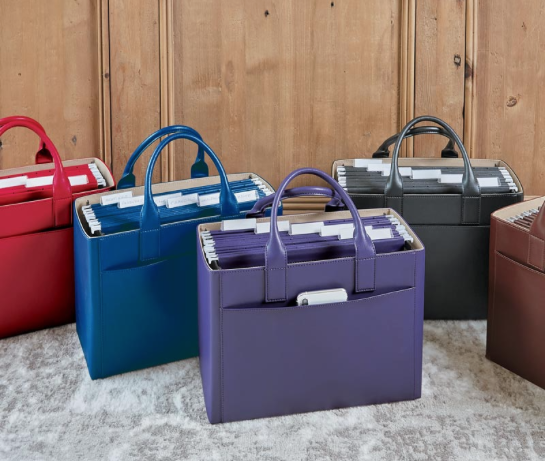



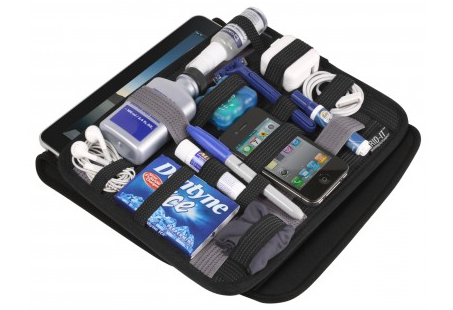
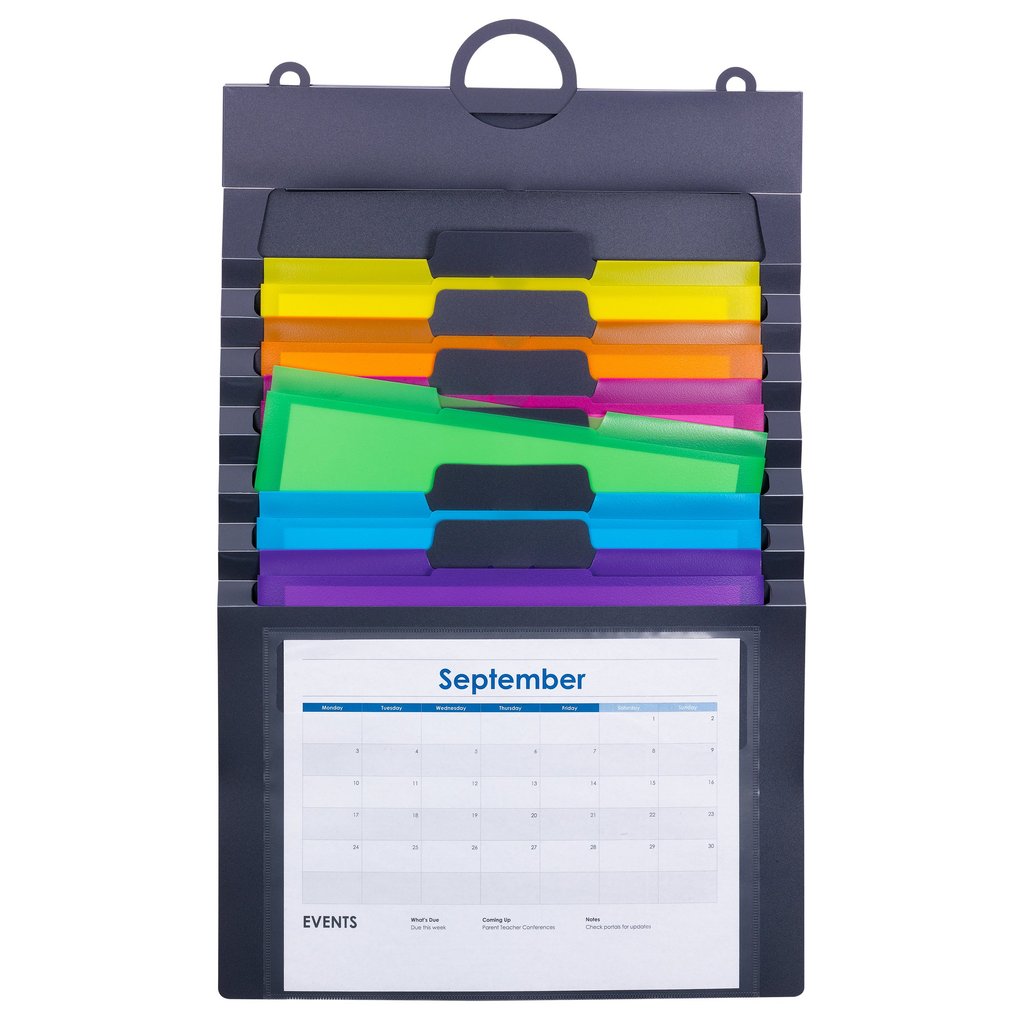
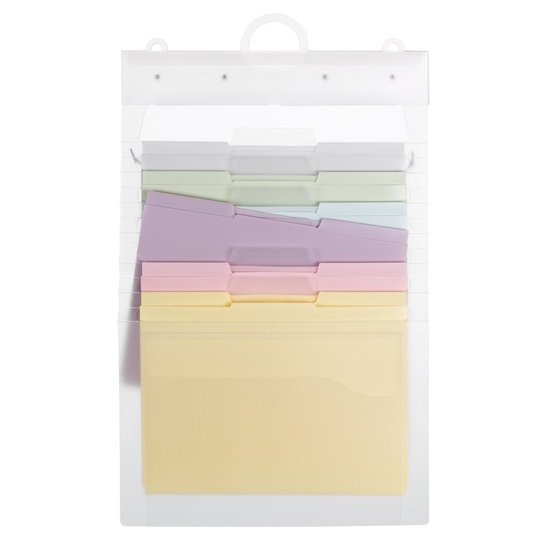
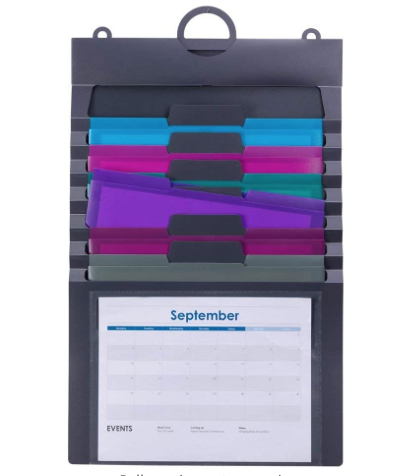
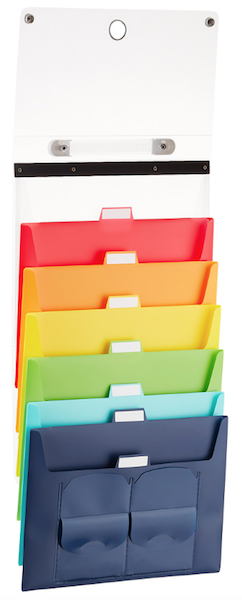

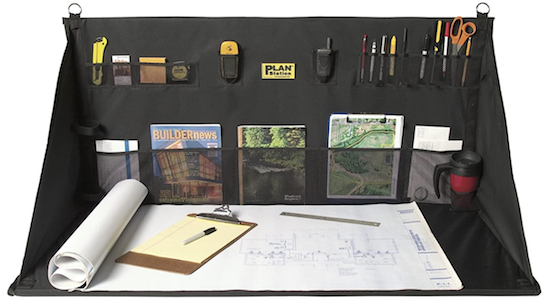



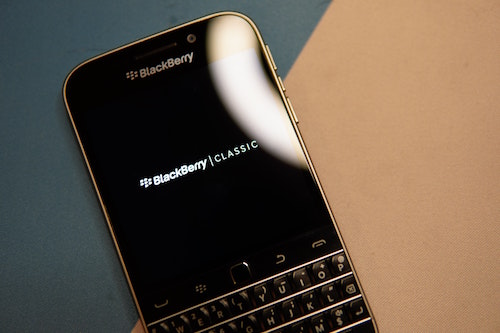

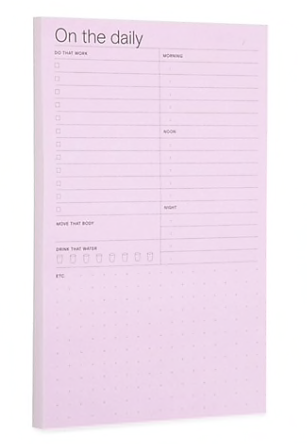



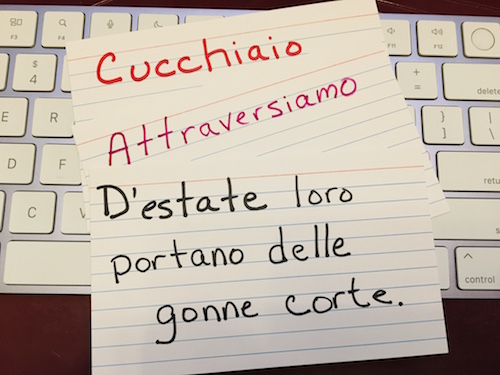
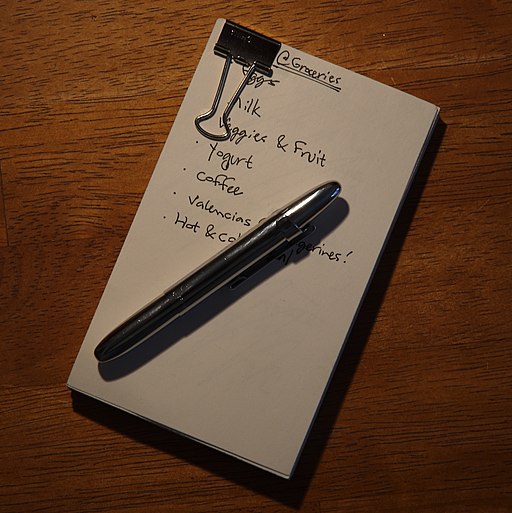

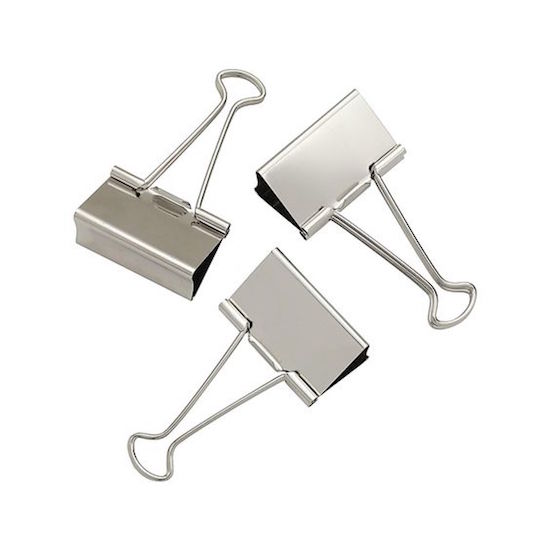
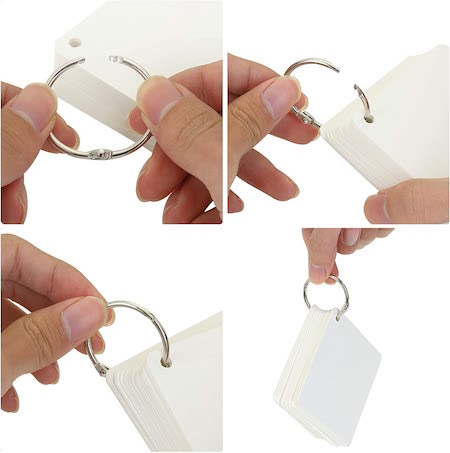
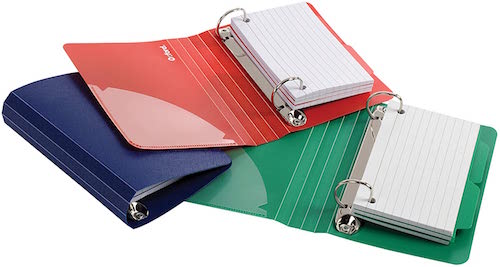
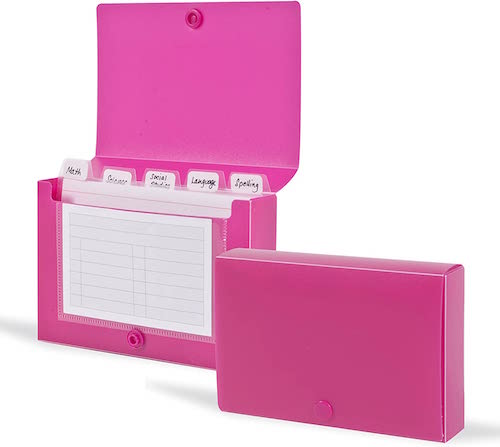

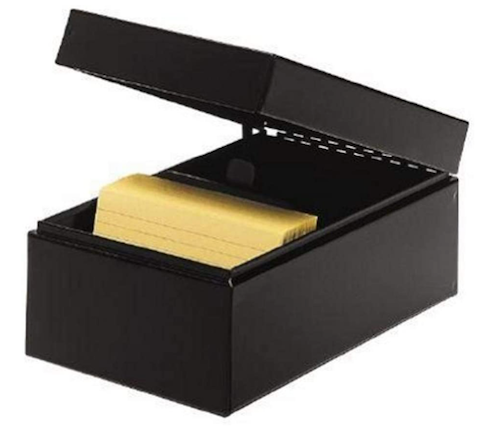
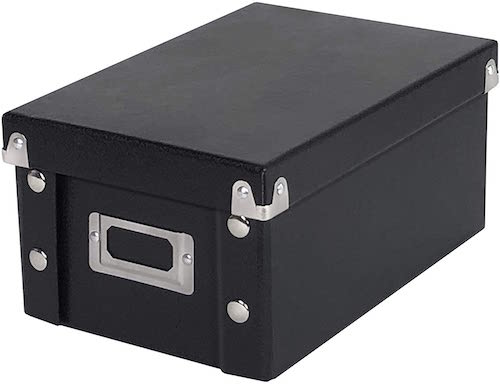
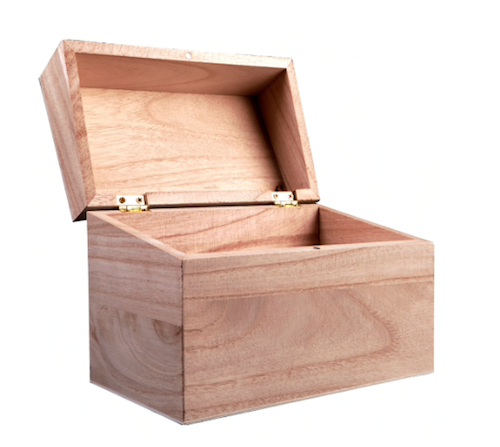
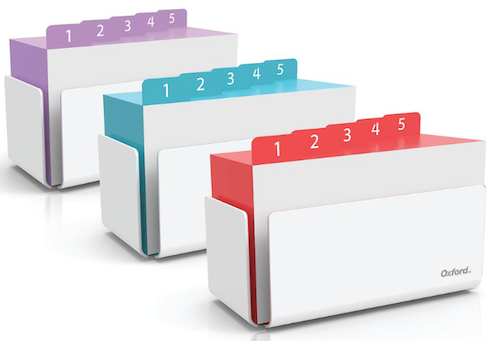
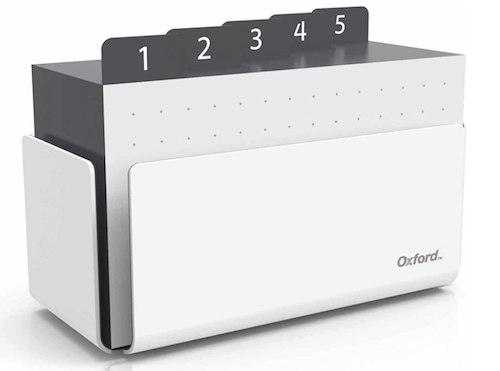



Follow Me